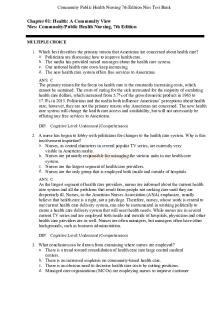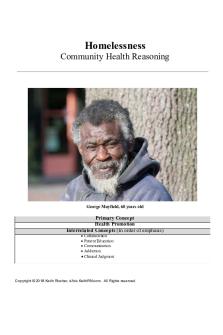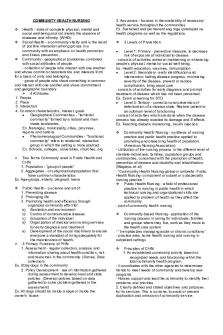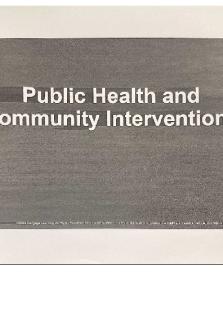Chapter 11 Community Mental Health PDF

| Title | Chapter 11 Community Mental Health |
|---|---|
| Author | Lora Sahmarani |
| Course | Introduction to Public Health |
| Institution | University of Toledo |
| Pages | 4 |
| File Size | 119 KB |
| File Type | |
| Total Downloads | 103 |
| Total Views | 157 |
Summary
Download Chapter 11 Community Mental Health PDF
Description
Chapter 11: Community Mental Health Introduction: ❖ Mental Illness: Leading cause of disability in North America and Europe ➢ ~20% of American adults have diagnosable mental disorders ❖ Only 38% receive treatment ❖ Needs of people with mental illnesses diverse ➢ Services required to meet needs include therapeutic and social services Definitions: ❖ Mental Health: Emotional and social well-being ❖ Mental Illness: All diagnosable mental disorders ❖ Mental Disorders: Health conditions characterized by alterations in thinking, mood, or behavior associated with distress and/or impaired functioning Good Mental Health: ❖ Adults with good mental health are able to: ➢ Function under adversity ➢ Change or adapt to changes around them ➢ Maintain control over their tension and anxiety ➢ Find more satisfaction in giving than receiving ➢ Show consideration for others ➢ Curb hate and guilt ➢ Love others Classification of Mental Disorders: ❖ Diagnostic and Statistical Manual of Mental Disorders, Fifth Edition (DSM-5) ➢ Published by American Psychiatric Association ➢ Most influential book in mental health ➢ Classifies disorders based on behavioral signs and symptoms rather than definitive tests or measurements of brain or another body system ➢ Challenges to diagnosis include comorbidity and lack of cultural competence Suicide and Substance Abuse: ❖ Led to an unexpected rise in death rates among middle-aged white Americans between 1999 and 2014 ❖ Prevalence of alcohol and other drug abuse a social indicator of mental illness problems History of Mental Health Care in United States Before World War II: ❖ Colonial America: people with mental illness cared for by families or private caretakers ❖ Institutionalization first appeared in 18th century ❖ Population growth led to institution growth ➢ Harsh treatments and unpleasant conditions The Moral Treatment Era: ❖ Began in 1792 ❖ Belief that environmental changes can affect the mind and alter behavior ➢ Move people from settings cause life stressors into rural, peaceful setting
❖ Appeared to have success and became widely acceptable ❖ Overcrowding due to population growth The State Hospitals ❖ Supposed to provide therapeutic environment, based on close personal relationships between patients and well-trained staff ❖ Deterioration of services occurred as chronic nature of mental illness was discovered; long-term or lifetime stays were the norm ❖ Maximum capacities quickly reached; personalized care lost; restraints became more practical; staff turnover high ❖ 1940, population in state mental institutions was nearly a half million ➢ Staff caseloads so large, only subsistence care possible ■ Electroconvulsive Therapy (ECT) introduced in response ❖ Lobotomies practiced ➢ Appearance of new medications in 1950s made widespread use unnecessary History of Mental Health Care in United States After World War II: ❖ National Institute of Mental Health (NIMH) established: ➢ To foster and aid research related to cause, diagnosis, and treatment of neuropsychiatric disorders ➢ To provide training and award fellowships and grants for work in mental health ➢ To aid states in the prevention, diagnosis, and treatment of neuropsychiatric disorders Deinstitutionalization: ❖ Deinstitutionalization: Discharging of thousands of patients from state mental hospitals ❖ Propelled by economics, idealism, legal considerations, and antipsychotic drugs Community Mental Health Centers: ❖ Mental Retardation Facilities and Community Mental Health Centers Act ❖ Community mental health centers- fully staffed centers originally funded by the federal government providing comprehensive mental health services to local populations ❖ Community mental health centers were to provide 5 core services: ➢ Inpatient care ➢ Outpatient services ➢ 24-hour emergency care ➢ Day treatment or other partial hospitalization services ➢ Consultation and education Mental Health Care Concerns in the United States Today: ❖ Experiences of people with serious mental illness have improved significantly in the past 50 years ❖ Challenges remain: ➢ How to provide services to the homeless ➢ Challenging perception that mental illness is linked to extreme violence ➢ Resolving problems of those with mental illness who are incarcerated
Homelessness: ❖ 2.1 million adults experience homelessness over the course of a year ➢ 80% temporarily homeless, 10% episodically homeless, 10% chronically homeless ❖ About half of all homeless adults have substance use disorders, major depression, and other co-occurring mental illness ❖ Successful interventions include provision of housing and services they need Mental Illness and Violence: ❖ Extreme violence relatively rare in people with mental disorders ➢ Much of risk attributable to comorbid factors ❖ What should be done to prevent violence is unclear ➢ Constitutional issues related to individual freedoms, privacy, and other rights Mental Health Care in Jails and Prisons: ❖ Rates of serious mental illness in US correctional facilities are three to four times the rates in the general population ❖ Correctional facilities designed to confine and punish, not to treat disease ➢ Lack of space, adequate number of qualified treatment personnel, and timely access to services ❖ Once released back into community, more likely to commit crime if untreated Prevention: ❖ Primary, secondary, and tertiary prevention applicable to mental disorders ❖ Primary: Reduces incidence of mental illness and related problems ❖ Secondary: Reduces prevalence by shortening duration of episodes ❖ Tertiary: Treatment and Rehabilitation Treatment Approaches: ❖ Goals of treatment of mental disorders ➢ Reduce symptoms ➢ Improve personal and social functioning ➢ Develop and strengthen coping skills ➢ Promote behaviors that make a person’s life better Psychopharmacology: ❖ Psychopharmacological therapy: treatment with medications ❖ Conditions for which medications exist include schizophrenia, bipolar disorder, major depression, anxiety, panic disorder, and obsessive-compulsive disorder ❖ Other biomedical therapy- ECT Psychotherapy: ❖ Treatment through verbal communication ❖ Numerous approaches ➢ Cognitive-behavioral therapy ❖ More likely to be successful in less severe cases or when used in conjunction with other approaches
Technology: ❖ Use of technology in treatment via telephone, video conferencing, Internet, email, computer software ❖ Benefits: ➢ Delivers flexible help directly to clients’ living environments ➢ Lowers cost to patient ➢ Increases privacy of patient ➢ May reduce feelings of coerciveness Self-Help Groups: ❖ Concerned members of the community who are united by a shared interest, concern, or deficit not shared by other members of the community ❖ National Alliance on Mental Illness (NAMI) ❖ Main Campus Counseling Center Psychiatric Rehabilitation: ❖ Primary objective is most often recovery rather than cure ❖ Psychiatric Rehabilitation: Current recovery-oriented services ➢ Services include medication, therapy, adaptive skills, changing environment through accommodations at work or school ➢ Practices must be evidence-based Challenges Facing Mental Health Care in the United States: ❖ Multiple services needed ❖ Staff turnover relatively high ❖ System is decentralized and fragmented ❖ Lack of licensed providers in rural and low-income countries ❖ Lack of cultural competence among providers Government Policies and Mental Health Care: ❖ Following deinstitutionalization, government’s role in a funding and policy became substantial ❖ Medicaid ❖ Mental Health Parity and Addiction Act of 2008 ➢ Parity: Concept of equality in health care coverage for people with mental illness and those with other medical issues or injuries The Affordable Care Act of 2010: ❖ Medicaid coverage for the individuals with mental disorders grew ❖ Individuals with mental disorders disproportionately benefit from coverage expansions ➢ They tend to have lower incomes and are less likely to be insured ❖ Communities may lack infrastructure to adequately meet needs of newly insured...
Similar Free PDFs

mental health chapter 3 HW
- 1 Pages

Mental Health
- 44 Pages

Community health final
- 14 Pages

Community Health Nursing RLE
- 15 Pages

Community Health Diagnosis
- 136 Pages

ATI Community Health Focus
- 24 Pages

ATI Community Health Study
- 22 Pages

Community Health Nursing Kaplan
- 41 Pages

Community Health Test Bank
- 10 Pages
Popular Institutions
- Tinajero National High School - Annex
- Politeknik Caltex Riau
- Yokohama City University
- SGT University
- University of Al-Qadisiyah
- Divine Word College of Vigan
- Techniek College Rotterdam
- Universidade de Santiago
- Universiti Teknologi MARA Cawangan Johor Kampus Pasir Gudang
- Poltekkes Kemenkes Yogyakarta
- Baguio City National High School
- Colegio san marcos
- preparatoria uno
- Centro de Bachillerato Tecnológico Industrial y de Servicios No. 107
- Dalian Maritime University
- Quang Trung Secondary School
- Colegio Tecnológico en Informática
- Corporación Regional de Educación Superior
- Grupo CEDVA
- Dar Al Uloom University
- Centro de Estudios Preuniversitarios de la Universidad Nacional de Ingeniería
- 上智大学
- Aakash International School, Nuna Majara
- San Felipe Neri Catholic School
- Kang Chiao International School - New Taipei City
- Misamis Occidental National High School
- Institución Educativa Escuela Normal Juan Ladrilleros
- Kolehiyo ng Pantukan
- Batanes State College
- Instituto Continental
- Sekolah Menengah Kejuruan Kesehatan Kaltara (Tarakan)
- Colegio de La Inmaculada Concepcion - Cebu






